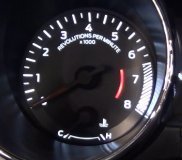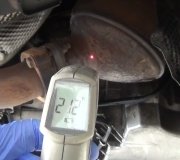Hi marbury1104. Welcome to the forum. What you described is typical for a worn inner cv joint housing, usually the right side, but since you replaced the entire shaft already, we have to look for something less common. The left joint can do this too but it doesn't happen as often.
So we don't overlook something, if you reposition the rollers within the housings and the vibration changes, we will have a clue. It is real easy to change the alignment angles (camber) on one or both front wheels to reposition the rollers, but without changing toe also, tire wear will result. A better way is to look at the engine mounts. I replaced a ton of rack and pinions and power steering hoses at the dealership, but I never had to do anything with engine mounts that I can recall, so I can't remember which mount positions the drive train, but it's usually the passenger side mount.
There will be some means of loosening one engine mount and prying it sideways to reposition the engine. The other two mounts will just slide along. If the vibration gets better or worse, an inner cv joint housing is the cause. Normally it will have worn areas the rollers are running through and binding on, but it is also possible for one of the tripods to be bottoming out and hitting inside the housing. A more common problem, especially since a new shaft didn't help, is a sagged mount. That can result in too great of an angle between the shaft and inner housing, and the two will contact each other. This would have to be coupled with reduced ride height due to aged coil springs because the design of the mount won't let the engine drop more than about an inch by itself. That alone isn't enough to cause the shaft and housing to touch because they have to be able to accommodate the normal suspension travel, but when the springs sag a little, the shaft angle will increase.
Also look at the tires and wheels. A slightly bent wheel or hub can cause a sideways thrust on the suspension system once per tire revolution that you might not normally feel, but at a certain speed it might hit the natural frequency of the drive train to rock back and forth which would amplify the effect. Similar to the tiny energy needed to keep a grandfather's clock pendulum swinging at its natural frequency. The easiest way to find this is to run the car in gear with the front end jacked up and resting with the lower control arms on jack stands. Jack stands under the frame will allow the lower control arms to droop and severely change the half shaft angles, causing or hiding possible problems. The jack stands will also keep the suspension stable while you do the next tests.
First, watch from the front of each tire for irregularities in the tire tread indicating a broken belt. I don't think, from your dandy description of the symptoms, that tire belts are the problem, but take a peek anyhow. Next, use a dial indicator on the outer lip of the wheels to check for sideways runout. Anything more than, ... Oh, ... Say.040" should be investigated. Besides the bent wheel or hub already mentioned, look for a warped brake rotor or, if the wheels where off recently, suspect a piece of rust or scale broke off and got stuck between the hub and rotor. Either of these can be found too with the dial indicator after the wheel is removed and the lug nuts reinstalled.
Even a warped brake rotor can cause a vibration like you described. The caliper must slide back and forth once per wheel revolution, but if it is a little tight due to dirt or rust on the mounting surfaces, it will tug on the spindle which will move against the rubber control arm bushings.
Caradiodoc
Wednesday, April 28th, 2010 AT 12:57 PM


